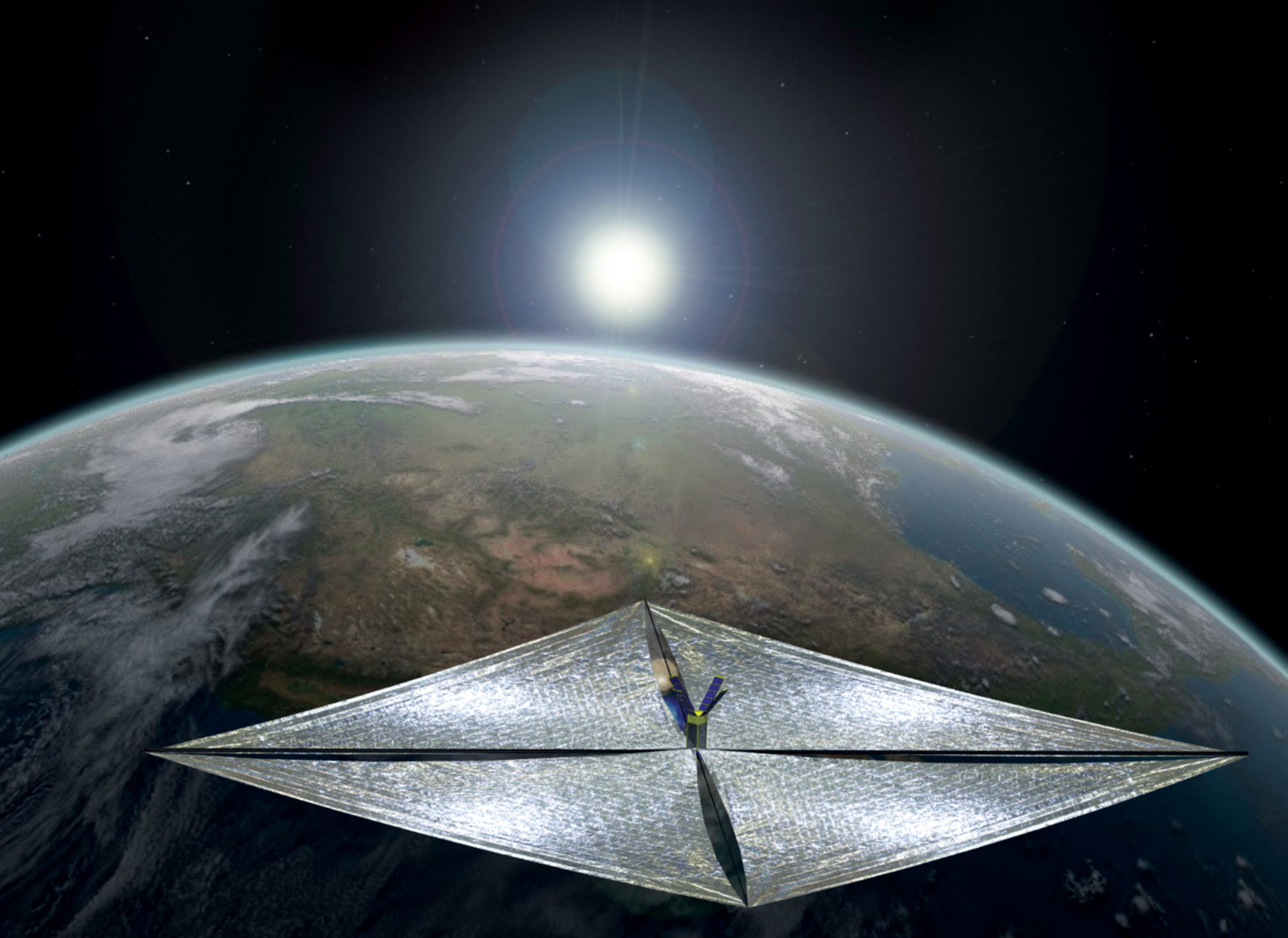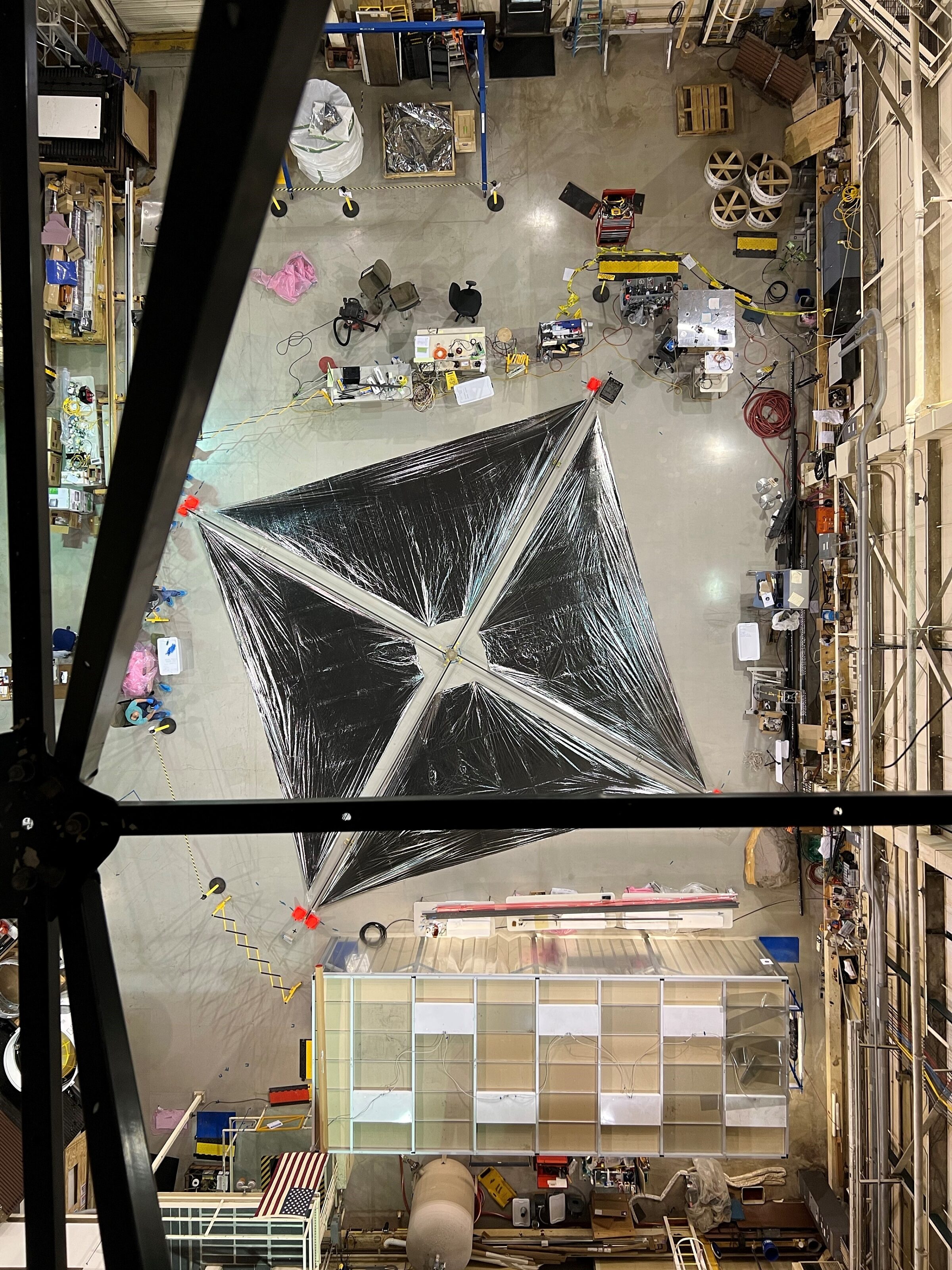The future of solar sailing
The Planetary Society's LightSail 2 spacecraft sailed into history last year, successfully completing its mission to demonstrate flight by light.
The solar sail reentered Earth’s atmosphere on Nov. 17, 2022 after 3 1/2 years in space. It was a bittersweet moment for Planetary Society members and supporters as well as the team that had flown the spacecraft since 2019. The reentry marks a turning point as the mission turns from operations to analysis and data archiving, said Bruce Betts, LightSail program manager and chief scientist for The Planetary Society.
“We don’t have to worry about flying the spacecraft every day,” he said. “Now we can focus on data analyses and presenting and publishing the results.”
LightSail 2 was a technology demonstration. It was designed to show that small spacecraft — in this case, standardized spacecraft called CubeSats — can carry, deploy, and utilize relatively large solar sails for propulsion. LightSail 2 began its mission as a CubeSat roughly the size of a loaf of bread and deployed a reflective Mylar solar sail with an area of 32 square meters (344 square feet). Using a momentum wheel and three electromagnetic torque rods, the spacecraft oriented itself each orbit to get a slight push from sunlight.
At LightSail 2’s starting altitude of about 720 kilometers (450 miles), Earth’s atmosphere is still thick enough to create drag and slow down a spacecraft. Using solar sailing, LightSail 2 slowed its decay rate and even overpowered drag on some occasions, showing that the technology is ready for wider use.
New solar sail missions are already under development. Solar sailing is being considered for a wide variety of applications as scientists and engineers envision new advancements in sail technology. LightSail 2 may be gone, but the future of solar sailing is bright.

A useful technology
One of the biggest advantages of solar sail-powered spacecraft is that while they are near the Sun, they enjoy unlimited thrust. This allows them to reach complex orbits that require constant acceleration to maintain.
An example of this is an orbit that would allow a spacecraft to continually circle the poles of a planetary body. A “pole sitter” spacecraft could offer insight into polar processes happening on Earth, the Moon, and other planets.
Another use for the technology could be parking a spacecraft between Earth and the Sun, creating an artificial orbit from which to watch for solar storms. Solar storms are ejections of high-energy particles from the Sun. These particles can disrupt power grids, cause communication blackouts, and harm astronauts in space. A solar sail parked between Earth and the Sun could sound the alarm on incoming solar storms, allowing protective measures to be taken.
Solar sailing could also propel spacecraft to distant destinations more quickly than conventional propulsion. Proposed far-flung targets range from the outer planets to the Oort cloud to our Sun’s gravitational lens region, where the Sun’s gravity magnifies distant objects in a way that might allow us to image an exoplanet in high resolution.
The ultimate destination for a solar sail would be Proxima Centauri, our stellar neighbor. The organization Breakthrough Starshot has proposed using lasers to accelerate tiny Proxima-bound spacecraft up to 20% the speed of light, cutting the travel time to just 20 years.
NASA solar sails
LightSail 2’s immediate solar sail successor was NASA’s Near-Earth Asteroid Scout. NEA Scout launched aboard the agency’s Artemis I Moon mission in November 2022 along with nine other CubeSats. Unfortunately, NEA Scout didn’t phone home as planned, and all efforts to communicate with the spacecraft failed.
The CubeSat was equipped with a solar sail roughly 2 1/2 times larger than that of LightSail 2. It would have used the sail to leave the vicinity of the Moon and perform a slow flyby of asteroid 2020 GE, which measures just 18 meters (60 feet) across. Had NEA Scout succeeded, 2020 GE would have become the smallest asteroid ever visited by a spacecraft.
The loss of NEA Scout came on the heels of news that NASA was no longer pursuing another solar sail mission named Solar Cruiser. Solar Cruiser would have deployed an ambitiously large solar sail with an area of 1,650 square meters (17,800 square feet), big enough to cover six tennis courts. The spacecraft would have parked itself in a straight line between Earth and the Sun, a location that future missions could use to watch for solar storms. Only a solar sail can reach and maintain such a unique orbit, given the perpetual thrust required.
That leaves NASA with just one upcoming solar sail mission: ACS3, the Advanced Composite Solar Sail System. ACS3 is scheduled to launch into Earth orbit as early as mid-2023 for a test of next-generation solar sail technologies.
The spacecraft will use carbon fiber booms to deploy a sail with an area of about 80 square meters (860 square feet) — about 2 1/2 times larger than LightSail 2. NASA says the carbon fiber booms are 75% lighter than metal booms and less susceptible to buckling due to extreme temperature shifts in space.
W. Keats Wilkie, the mission’s principal investigator at NASA’s Langley Research Center, said ACS3 is essentially a scaled-down version of a much larger solar sail spacecraft that would measure roughly 500 square meters (5,400 square feet). He said that as the technology matures, scientists will come to see solar sail spacecraft as attractive options for their missions.
“Once we start flying these, we’ll get people who say, ‘Hey, this isn’t just science fiction anymore,’” he said.

No booms, no problem
The larger a solar sail gets, the more challenging it becomes for booms to deploy sail sections and hold them tight like a kite. One alternative is spinning the core spacecraft using centrifugal force to unfurl the sail and keep it tight. The concept was successfully tested in 2010 by Japan’s IKAROS mission. Now, a French-based startup named Gama plans to take spinning sails further.
Gama is planning to debut the technology in Earth orbit with two missions named Alpha and Beta. Both will use sails of 73 square meters (786 square feet), more than double the sail area of LightSail 2.
In January 2023, Alpha launched to low-Earth orbit, where atmospheric drag is still strong enough to overpower the thrust gained from solar sailing. At the time of publication, no information was available about the status of the spacecraft. Beta, which has a launch date of 2024, will fly higher, where its thrust will have a more noticeable effect.
Gama’s goal is to offer an affordable solar sailing platform for a variety of scientific missions. The company’s website envisions flights to Venus, the outer planets, and even the Oort cloud. Andrew Nutter, a Gama co-founder, said that the company’s solar sails will hitch rides on high-energy rocket launches, such as trips to lunar space.
“It allows us to launch as a rideshare on many different types of missions without needing a private launch, reducing launch cost,” he said.
Other types of sailing
Solar sails like LightSail 2 work on a straightforward concept: As light bounces off a reflective surface, some of the light’s momentum gets transferred, giving the surface a push. Like a sailboat, a solar sail gets where it wants to go by changing the angle of its sail with respect to the Sun’s rays.
A reflective sail performs best when it is turned perpendicular to the rays, but this isn’t always possible. A sail in solar orbit trying to spiral away from the Sun, for instance, needs to angle itself 35 degrees away from the incoming solar photons. This lowers the sail’s thrust, making it less efficient.
Diffractive solar sails seek to overcome this limitation. These sails use tiny gratings that diffract incoming light through the sail like a prism rather than reflecting it. The diffracted light has a force component that pushes the sail in a direction perpendicular to the incoming solar photons, allowing the sail to capture the full force of the Sun’s rays.
Rather than being made from shiny Mylar like LightSail 2, a diffractive solar sail might be manufactured from nearly transparent materials. As an aesthetical bonus, the diffracted light would give the sail a rainbowlike appearance.
The NASA Innovative Advanced Concepts program has previously funded diffractive sail research. The agency is now funding further development of diffractive sails in support of a possible technology demonstration mission. Amber Dubill, the project’s principal investigator at the Johns Hopkins University Applied Physics Laboratory, said that diffraction technology could help make solar sailing mainstream.
“We think that we can overcome a lot of the challenges that are keeping traditional solar sailing from becoming widely implemented much more across the board,” she said.
Another alternative to traditional solar sails is the electric sail, or E-sail. Instead of sailing on solar photons traveling at the speed of light, an E-sail rides on the solar wind — charged particles ejected by the Sun.
One E-sail concept studied by NASA’s Marshall Space Flight Center consists of a small central spacecraft that would spin and deploy 20 thin, positively charged wires that are each 20 kilometers (12 miles) long.
As positively charged protons from the solar wind approach the sail, they are repelled by electrostatic forces, giving the sail a push. One advantage of this technique is that E-sails could be faster than traditional sails. NASA says an E-sail-powered mission could reach the heliopause — the bubble in interstellar space created by our Sun — in half as much time as a solar sail.

What a drag
During its final days in space, LightSail 2 dipped farther and farther into Earth’s atmosphere. The spacecraft’s altitude dropped quickly as its kitelike sail trawled through the upper atmosphere. The forces and heating from air molecules compressed against LightSail 2’s surfaces eventually tore apart the spacecraft.
Data on LightSail 2’s reentry could prove useful for drag sails, which are designed to intentionally deorbit satellites. The capability can be used to speed up the reentry of satellites whose missions have ended, ensuring they don’t contribute to a growing space junk problem in Earth orbit. NASA says there are over 25,000 objects in Earth orbit larger than 10 centimeters (4 inches). Derelict satellites can collide with other satellites and space debris, exacerbating the problem.
Satellites can be equipped with drag sails that are deployed at the end of a mission. Several organizations are studying the concept, including the company Vestigo Aerospace, which includes personnel who worked on the LightSail program.
LightSail’s legacy
LightSail 2 was designed to demonstrate flight by light for small spacecraft. The LightSail program itself had wide-ranging objectives, including popularizing solar sailing and helping other missions advance solar sailing technology.
More than 50,000 Planetary Society members, Kickstarter backers, private citizens, foundations, and corporate partners supported LightSail 2 and the broader cause of solar sailing. With a variety of new missions and technologies on the way, the future of solar sailing looks bright. From its nighttime launch to the stunning images it sent back to Earth, LightSail 2 has inspired people far and wide.
The co-founders of The Planetary Society believed that sailing on sunlight could revolutionize space travel. As the LightSail 2 mission ends, the baton is being passed to the next generation of solar sailors. Who knows what distant shores they will visit as they explore our cosmic ocean?
Let’s Go Beyond The Horizon
Every success in space exploration is the result of the community of space enthusiasts, like you, who believe it is important. You can help usher in the next great era of space exploration with your gift today.
Donate TodayThe Planetary Report • March Equinox
Help advance space science and exploration! Become a member of The Planetary Society and you'll receive the full PDF and print versions of The Planetary Report.


 Explore Worlds
Explore Worlds Find Life
Find Life Defend Earth
Defend Earth



